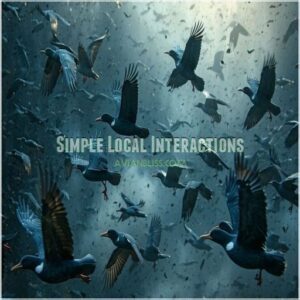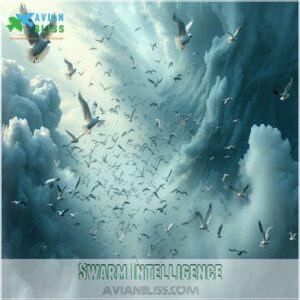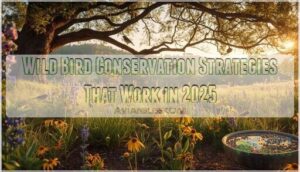This site is supported by our readers. We may earn a commission, at no cost to you, if you purchase through links.
 Bird flocking behavior is nature’s masterpiece of survival strategy.
Bird flocking behavior is nature’s masterpiece of survival strategy.
Through sophisticated visual and acoustic communication, birds observe multiple neighbors simultaneously, executing synchronized turns that look almost choreographed.
Their swarm intelligence enables collective decision-making, where simple local interactions transform individual birds into a unified, dynamic system.
You’ll see them coordinate movements with jaw-dropping precision, creating living shields against predators and conserving energy during migration.
Whether it’s starling murmurations or geese in V-formations, these feathered friends aren’t just flying—they’re performing an intricate dance of survival that’ll make you see the sky differently.
Table Of Contents
- Key Takeaways
- What is Flocking Behavior
- Benefits of Flocking Behavior
- Flock Structure and Dynamics
- Migration and Flocking Patterns
- Communication and Coordination
- Historical and Scientific Interpretations
- Current Research and Future Directions
- Frequently Asked Questions (FAQs)
- What is flocking behavior?
- How do birds lead a flock?
- What does a flock of birds indicate?
- What are the benefits of flock behavior in birds?
- How do birds navigate within a flock?
- Why do birds live in a flock?
- What does it mean when birds flock?
- What is an example of flocking behavior?
- How do birds decide who leads the flock?
- What are the rules of flocking?
- Conclusion
Key Takeaways
- You’ll discover that flocking isn’t just a pretty aerial display, but a sophisticated survival strategy where birds use collective intelligence to reduce predation risks and conserve energy during migrations.
- By tracking 6-7 neighboring birds simultaneously, each individual contributes to complex group dynamics, creating synchronized movements that are faster and more efficient than any single bird could achieve alone.
- You’ll witness how simple local interaction rules transform individual bird behaviors into breathtaking collective patterns, where each bird adjusts speed and direction in milliseconds without a central leader.
- When you look at bird flocks, you’re seeing nature’s ultimate collaborative defense mechanism, where group communication, spatial awareness, and swarm intelligence turn potential vulnerability into a powerful survival advantage.
What is Flocking Behavior
You’ve witnessed the mesmerizing dance of birds in the sky, where hundreds or even thousands move as if they’re a single, living organism.
Flocking behavior is a fascinating phenomenon where birds coordinate their movements, creating intricate aerial displays.
These displays serve critical survival purposes like predator protection, efficient navigation, and energy conservation during migration.
Definition and Examples
Bird flocking—a mesmerizing aerial ballet of coordinated movement—reveals nature’s intricate social strategies.
You’ll find these dynamic formations across diverse species, from starlings’ breathtaking murmurations to robins gathering in massive winter roosts.
Flocking isn’t just random clustering; it’s a sophisticated survival mechanism where birds create living, breathing patterns that transform individual vulnerability into collective strength.
By employing techniques like cooperative hunting strategies, birds further enhance their chances of survival in a challenging environment.
Types of Flocks
Ever watched birds group up and wondered about their secret societies?
Flock sizes and shapes tell a wild story of survival. From compact clusters to sprawling V-formations, these bird aggregations aren’t random.
Mixed flocks blend different species, while seasonal gatherings reveal nature’s intricate social networks.
Understanding bird flock types can also provide insight into these complex social structures.
Your backyard might be hiding a fascinating world of strategic bird flocking behavior.
Flocking in Different Bird Species
When exploring species variations, you’ll find flock behavior isn’t a one-size-fits-all phenomenon.
Different bird species showcase unique social behaviors that reveal nature’s intricate survival strategies:
- Starlings form mesmerizing murmurations with up to 150,000 individuals
- Mixed-species flocks offer collaborative protection in woodland environments
- Migratory birds like Amur falcons travel in massive groups spanning continents
Their communication styles and adaptability prove survival’s ultimate collaborative art.
Benefits of Flocking Behavior
You’re about to uncover the remarkable survival strategies birds employ through flocking.
Flocking transforms individual vulnerability into an extraordinary defense mechanism.
By moving together, birds create a complex, dynamic shield.
This dramatically reduces predation risks and enhances their chances of survival across diverse environments.
Safety in Numbers
Bird flocking isn’t just a stunning aerial dance—it’s a survival strategy that turns individual vulnerability into collective strength.
Imagine being part of a living, breathing shield where your odds of survival skyrocket. Nature’s safety net transforms potential prey into an intimidating defense mechanism, making predators think twice before attacking.
As observed in amazing bird behaviors explained, birds also employ complex communication signals to maintain social bonds, further increasing their survival advantage.
| Predator Challenge | Flock Response |
|---|---|
| Single Bird Risk | Reduced Dramatically |
| Visual Confusion | Highly Effective |
| Attack Probability | Substantially Lowered |
| Movement Complexity | Increases Exponentially |
| Survival Advantage | Maximized |
Increased Foraging Efficiency
A flock’s magic transforms foraging from a solitary grind into a collective feast.
By reducing individual vigilance, birds maximize food discovery and sharing opportunities.
Decreased competition and enhanced group hunting strategies allow flocks to efficiently locate resources, dramatically improving foraging efficiency.
Each member benefits from collective intelligence, turning scattered search efforts into a synchronized, strategic food acquisition mission.
Enhanced Predator Protection
After maximizing food sources through coordinated foraging, birds leverage an even more impressive survival strategy: enhanced predator protection.
Flocking creates a sophisticated defense mechanism where individual vulnerability plummets.
The "dilution effect" means predators struggle to target specific individuals amid swirling masses. Group vigilance amplifies warning signals, while the confusion effect renders attackers’ strategies ineffective, transforming collective movement into a living, breathing shield of survival.
Energy Conservation During Migration
Imagine soaring with geese in perfect V-formation, slicing through wind like nature’s ultimate energy-saving hack. Migration strategies reveal incredible aerodynamic efficiency for birds, dramatically reducing metabolic rates during long journeys.
Wind patterns become their secret weapon, transforming group flight into a collaborative survival technique.
- Minimize individual energy expenditure
- Rotate leadership positions mid-flight
- Leverage collective drafting benefits
- Share atmospheric navigation challenges
- Optimize seasonal migration routes
Aerodynamic efficiency and energy-saving are achieved through these strategies.
Flock Structure and Dynamics
You’re about to unravel the intricate dance of bird flocking, where individual birds transform into a living, breathing organism through complex interactions and swarm intelligence.
As you explore the mesmerizing world of flock structure and dynamics, you’ll discover how simple local rules create breathtaking aerial displays.
These displays blur the lines between individual and collective behavior.
Visual Cues and Vocalizations
In the intricate world of bird flocking, visual signals and vocalizations form the backbone of communication.
Birds use quick eye movements, wing postures, and distinct calls to coordinate their collective dance across the sky.
These nonverbal cues and vocal exchanges create a complex system that promotes flock cohesion and synchronized movement through shared environmental cues, often captured in mesmerizing bird flocking videos.
Simple Local Interactions
Diving deep into bird flocking, local interactions reveal a stunning dance of coordination.
Each bird tracks nearby neighbors, adjusting speed and direction with split-second precision.
By maintaining careful spacing and alignment, birds create mesmerizing collective movements.
Neighbor influence drives flock cohesion, where simple rules transform individual actions into breathtaking synchronized flight patterns.
Swarm Intelligence
Zooming out from local bird interactions reveals something magical: swarm intelligence.
Birds create stunning collective decision-making without a central leader, using decentralized control and adaptive systems.
Each bird follows simple rules, yet together they generate complex emergent behavior.
Their flocking dynamics showcase how individual actions can produce breathtaking, coordinated motion through shared information and intuitive responses.
Leadership Roles in Flocks
Within bird flocks, experienced leaders emerge naturally through age and environmental knowledge. These seasoned individuals subtly guide flock formations by leveraging their understanding of communication styles and dominance hierarchies. Older birds often take strategic positions, influencing group movement and decision-making through nuanced social interactions that maximize the collective’s survival and navigation.
Additionally, an elongated neck is a highly specialized tool that, as an advantage, assists in foraging, predator detection, thermoregulation, and courtship displays.
Migration and Flocking Patterns
You’ll be amazed by the intricate dance of bird migration, where thousands of feathered travelers synchronize their movements across continents in breathtaking formations.
When you observe geese flying in perfect V-shapes or starlings creating mesmerizing aerial patterns, you’re witnessing a complex survival strategy that’s evolved over millions of years.
V-Formation in Geese
Ever watched geese slice through the sky in a perfect V? This iconic flight formation isn’t just for show—it’s a brilliant energy efficiency strategy.
By carefully positioning themselves, each bird reduces wind resistance for those behind, cutting flight effort by up to 70%.
The lead goose works hardest, rotating leadership to distribute the energetic burden during long migrations.
Stream Flocking and Cluster Flocking
You might wonder how birds navigate complex flocking strategies during migration.
- Stream flocks form long, thin migration lines
- Cluster flocks create unstructured, dynamic groups
Flock size impacts energy efficiency. Density variations influence predator avoidance. Spatial relationships determine group survival.
These flocking behaviors demonstrate nature’s intricate survival strategies, balancing individual needs with collective protection.
Wave Flocking and Hover Flocking
Wave flocking creates mesmerizing patterns that look like nature’s synchronized dance.
Birds navigate through stunning wavelike formations, seamlessly shifting positions to maximize energy efficiency and communication.
These dynamic wave patterns serve as critical survival strategies, allowing birds to respond quickly to environmental challenges while maintaining group cohesion and minimizing predator detection risks during complex aerial movements. Wave flocking is a key element of bird survival.
Column Flocking
As bird flight patterns shift from waves to vertical columns, column flocking emerges as a fascinating strategy for survival. Birds create living towers that challenge our understanding of movement and coordination. Column flocking may be an adaptation to bird migration patterns.
- Breathtaking vertical formations slice through the sky
- Precision that defies individual bird capabilities
- A symphony of collective intelligence
- Nature’s ultimate survival strategy unfolding mid-air
Column flocking showcases remarkable environmental adaptations, where energy efficiency meets avoidance in a mesmerizing aerial dance.
Communication and Coordination
You’ll discover that birds aren’t just flying in a random bunch, but communicating through sophisticated, almost instantaneous signaling systems that coordinate their collective movements.
By observing multiple neighbors and responding to subtle visual and acoustic cues, these feathered performers execute breathtaking aerial choreographies.
These choreographies challenge our understanding of group communication.
Acoustic and Tactile Communication
After geese slice through migration skies, birds rely on a secret communication network that would make spy agencies jealous.
Acoustic signals and tactile cues weave through flocking patterns, creating complex bird communication strategies.
Your flock’s survival depends on intricate vocalizations that transmit environmental risks, synchronize movements, and maintain social bonds across multiple communication ranges.
Understanding bird behavior is essential for developing effective collision reduction technologies.
Observing Multiple Neighbors
Birds don’t just watch their closest neighbor—they keenly track multiple neighbors simultaneously.
This spatial awareness drives flock cohesion and sophisticated decision-making.
By observing 6-7 surrounding birds, each individual contributes to complex group dynamics, creating a seamless social network that enables rapid, synchronized movements through intricate local interactions.
Chorus Line Hypothesis
Zooming in on neighbor interactions, Wayne Potts’ chorus line hypothesis reveals the magic behind synchronized bird movements. Like a perfectly choreographed dance, flock turns spread with lightning speed through intricate communication networks.
- Wave propagation happens faster than individual reaction times
- Multiple neighbors influence each turn
- Synchronized movements emerge from simple rules
- Visual cues trigger collective responses
- No single bird leads the entire performance
chorus line hypothesis synchronized bird movements flock turns
Spatial Relationships in Flocks
After the chorus line hypothesis reveals how birds turn in waves.
Scientists zoom in on the intricate spatial relationships within flocks. Imagine a dynamic, three-dimensional dance where each bird maintains precise neighbor distances, creating complex flock density patterns.
These spatial relationships aren’t random—they’re a carefully choreographed survival strategy that maximizes group cohesion and protection. group cohesion and protection.
Historical and Scientific Interpretations
You’ll find the history of bird flocking behavior riddled with fascinating theories that range from divine intervention to early scientific speculation.
Modern research and computer models have revolutionized our understanding of these remarkable avian formations.
Ancient Theories and Early Concepts
As you explore bird flocking communication, ancient beliefs about these mesmerizing formations take flight. Early observers saw more than simple bird behavior – they glimpsed mysterious connections between animals.
Their interpretations of bird flocking patterns ranged from mystical to miraculous:
- Divine intervention explaining collective movements
- Natural telepathy between birds
- Concepts of a shared "group soul"
- Unexplained spiritual connections transcending individual consciousness
Early birdwatchers noticed that birds employed strategic midday routines, such as flocking for safety, to conserve energy and avoid predators.
These imaginative explanations captured humanity’s wonder before scientific understanding emerged.
Modern Research and Empirical Evidence
Breaking free from ancient mystical explanations, modern bird flocking research has uncovered precise mechanisms behind these mesmerizing aerial displays.
Scientists now use advanced technologies to map starling murmuration dynamics, tracking individual bird movements and decoding the sensory cues that drive collective behavior.
These empirical studies reveal the intricate dance of swarm intelligence in flight.
Computer Models and Simulation
Building on earlier research, computer models shed light on the mysteries of bird flocking with groundbreaking simulation techniques.
Sophisticated algorithms decode complex avian movements, revealing how birds navigate collective behavior.
These bird flocking simulations capture intricate patterns through model accuracy and strategic data validation, offering unprecedented insights into the swarm intelligence driving nature’s most mesmerizing aerial choreography.
Insights From Fish Schools
You might find it surprising how fish schools mirror bird flocking behavior. Both showcase remarkable collective motion strategies for survival.
Schooling behavior is also found in products that mimic fish schooling patterns.
Schooling includes:
- Predator avoidance through coordinated movement
- Reduced individual risk
- Enhanced foraging efficiency
- Swarm intelligence optimization
These parallel evolutionary adaptations reveal nature’s ingenious approach to collective animal behavior, demonstrating how group dynamics transcend species boundaries.
Current Research and Future Directions
You’ll be amazed by the cutting-edge research transforming our understanding of bird flocking dynamics.
From the StarFLAG project’s high-speed cameras to emerging theories about collective behavior.
As scientists continue exploring the intricate spatial relationships and communication strategies of flying flocks, you’ll discover how these feathered formations reveal nature’s most sophisticated survival strategies.
StarFLAG Project and High-Speed Cameras
The StarFLAG project revolutionizes our understanding of starling murmuration through cutting-edge high-speed cameras.
Researchers capture intricate 3D flock structures with millisecond precision, revealing how individual birds maintain incredible spatial relationships during flight.
These high-speed analyses expose the complex maneuverability of starlings, mapping out their breathtaking flight patterns with unprecedented scientific clarity.
Exploring Flock Behavior and Dynamics
Building on the StarFLAG project’s insights, scientists are peeling back the layers of flock behavior dynamics.
Researchers have uncovered fascinating patterns that reveal how birds communicate and coordinate their movements.
Here’s what makes flock dynamics so mind-blowing:
- Spatial awareness trumps individual instincts
- Complex communication happens in milliseconds
- Birds track multiple neighbors simultaneously
- Collective intelligence drives group movement
- Evolutionary adaptations shape flock strategies
These discoveries illuminate the intricate dance of collective bird behavior.
Safety of Numbers and Selfish Herd Theory
Ever wonder how birds dodge danger?
William Hamilton’s "selfish herd" theory explains why critters bunch up. Survival isn’t about altruism – it’s pure self-preservation.
Check out this breakdown of nature’s survival strategy:
| Behavior | Individual Risk | Group Impact |
|---|---|---|
| Solo | High | Vulnerable |
| Grouped | Reduced | Protected |
| Strategic | Minimal | Maximized |
Predation risk plummets when you’ve got backup – nature’s ultimate survival hack!
Ongoing Research and Emerging Trends
After understanding how birds self-protect, researchers are pushing boundaries with cutting-edge 3D flock modeling and AI analysis.
Sensor technologies reveal intricate swarm intelligence dynamics, while climate change studies track shifting avian flocking patterns.
Conservation teams now use advanced bird flocking algorithms to predict migration routes, offering unprecedented insights into collective behavior’s complex survival strategies.
Frequently Asked Questions (FAQs)
What is flocking behavior?
Flocking behavior is a synchronized movement strategy where animals, like birds, coordinate their actions to enhance survival.
You’ll see them move as one, dodging predators and conserving energy through collective intelligence and instinctive communication.
How do birds lead a flock?
Think leading a flock’s a democracy? Think again!
Birds don’t elect leaders; instead, experienced individuals subtly guide movement.
Through nuanced visual cues, spatial positioning, and collective decision-making based on swarm intelligence and environmental knowledge.
What does a flock of birds indicate?
A bird flock can signal migration, roosting preparation, predator response, or social gathering.
You’ll spot seasonal movements, environmental shifts, or group survival strategies through their coordinated, mesmerizing aerial displays and collective behaviors.
What are the benefits of flock behavior in birds?
Imagine surviving with only 40% predation risk in a flock!
You’ll find safety, energy conservation, and collective intelligence through coordinated movement.
Birds leverage group dynamics to forage, migrate, and dodge threats more effectively than flying solo.
How do birds navigate within a flock?
Birds navigate flocks using visual cues and subtle movements.
They track 6-7 neighbors simultaneously.
Adjusting speed and direction through quick, coordinated responses creates seemingly magical group movements without a central leader.
Why do birds live in a flock?
You’ll flock together for safety, warmth, and survival.
By sticking close, you’ll dodge predators more easily.
find food faster, and share essential information that keeps your entire group alive and thriving in tough environments.
What does it mean when birds flock?
When nature’s aerial symphony swirls, birds aren’t just dancing—they’re surviving.
Flocking means protection, shared intelligence, and collective energy conservation.
Helping them navigate predators, find food, and migrate with remarkable synchronicity and efficiency.
What is an example of flocking behavior?
Imagine starlings dancing across the sky in a massive, swirling murmuration.
Thousands of birds move as one, shifting and swooping in perfect synchronization.
This creates a breathtaking aerial display that confuses predators and demonstrates nature’s incredible coordination.
How do birds decide who leads the flock?
Don’t assume there’s a single boss bird!
Flock leadership emerges dynamically through swarm intelligence, with experienced birds subtly influencing movement.
Older, knowledgeable individuals may temporarily guide the group based on environmental cues and survival strategies.
What are the rules of flocking?
When you fly with others, follow three simple rules: avoid colliding, stay close to neighbors, and match their speed and direction.
Each bird watches 6-7 nearby flyers, creating mesmerizing synchronized movements.
Conclusion
You’ve witnessed how these winged marvels transform individual limitations into collective intelligence through bird flocking behavior.
Their synchronized movements aren’t just beautiful—they’re survival mechanisms that optimize safety, energy consumption, and navigation.
By observing multiple neighbors simultaneously, birds create dynamic, adaptive systems that outperform individual capabilities.
Ultimately, bird flocking behavior reveals nature’s elegant problem-solving strategy.
Next time you see a murmuration, you’ll recognize the sophisticated communication and survival tactics at play.
- https://birdfact.com/bird-behavior/social-structures/flocking-behavior
- https://www.birdful.org/what-does-it-mean-when-a-bunch-of-birds-are-flying-around/
- https://www.audubon.org/magazine/march-april-2009/how-flock-birds-can-fly-and-move-together
- https://news.mongabay.com/2018/04/developing-bird-risk-reduction-technologies/
- https://academic.oup.com/beheco/article/28/3/645/3075088
















